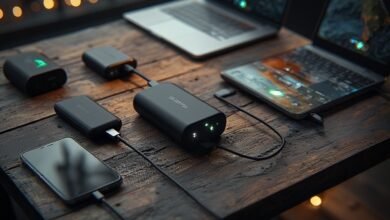AI-Integrated Smart Home Devices & Robots: The Future of Living
In 2025, the concept of a smart home has evolved from simple voice assistants and automated lights to fully AI-integrated ecosystems. Today’s devices and robots are not just programmable tools — they are learning companions that adapt to lifestyles, predict needs, and even perform chores with remarkable efficiency. From cleaning robots that map your home in 3D to AI-powered kitchen assistants, the future of convenience, safety, and personalization is here.
🏡 Why AI Matters in Smart Homes
Traditional smart home devices relied on fixed commands: “Turn off the light” or “Lock the door.” But AI integration adds contextual intelligence.
- Devices learn from habits and preferences.
- Robots adapt to different environments and tasks.
- Predictive features save time and energy.
👉 Instead of just following orders, AI-powered gadgets now anticipate needs — dimming lights before bedtime, adjusting thermostats based on weather, or sending alerts when groceries are running low.
🧹 Cleaning Robots: Smarter Than Ever
The robot vacuum has become a household staple, but in 2025, it’s much more than just a sweeper.
- AI Mapping: Robots like the iRobot Roomba j7+ use vision-based navigation to avoid clutter.
- Multi-Tasking: Models now mop, vacuum, and even empty themselves.
- Custom Scheduling: AI learns your cleaning patterns — for instance, running right after you leave for work.
👉 Comparison Insight: Premium brands like iRobot and Roborock dominate with advanced AI, while budget-friendly alternatives such as Eufy appeal to those who want smart cleaning without the hefty price tag.
🍳 AI in the Kitchen: Cooking Meets Convenience
Cooking robots and AI-infused appliances are transforming the kitchen.
- Smart Ovens recognize food and set the right cooking mode automatically.
- AI Recipe Assistants suggest meals based on what’s in your fridge.
- Robotic Chefs (still niche but rising) can stir, chop, and even plate food.
This sector reflects the growing trend of functional AI, helping households save time while still eating fresh, home-cooked meals.
🎥 Security & Monitoring Devices
Home safety is one of the biggest drivers of AI adoption.
- AI Cameras distinguish between a stranger, a delivery person, or a family member.
- Smart Doorbells filter notifications to avoid false alarms.
- Predictive Alerts use behavior patterns to spot unusual activity.
👉 Comparison: Ring and Nest lead mainstream adoption, while brands like Arlo and Eufy offer privacy-first solutions appealing to users wary of constant cloud monitoring.
💡 Lighting, Climate & Energy Efficiency
AI-driven devices also bring sustainability benefits.
- Smart Thermostats (like Nest and Ecobee) adapt to your schedule and local weather.
- AI Lighting Systems mimic natural daylight patterns to improve mood.
- Energy Management Bots track usage and suggest ways to cut bills.
Here, AI isn’t just about comfort — it’s about eco-conscious living in line with global sustainability trends.
🛋️ Robots for Everyday Living
Beyond cleaning and cooking, new robots are being designed for companionship and lifestyle support.
- Pet Care Robots: Feed, play, and monitor pets when you’re away.
- Elderly Assistance Bots: Provide reminders for medication, mobility support, and emergency alerts.
- Social Robots: Act as AI companions, especially popular in households with kids or single professionals.
👉 This space highlights the humanization of AI, where technology blurs the line between utility and companionship.
🌟 Big Tech vs. Indie Innovators
🏢 Big Players (Amazon, Google, Samsung)
- Offer integrated ecosystems (Alexa, Google Home, SmartThings).
- Best for users who want all-in-one compatibility.
🚀 Indie & Niche Brands
- Focus on specialized robots like advanced vacuums, pet companions, or AI wellness devices.
- Appeal to consumers who want innovation outside of major tech ecosystems.
👉 Comparison: Big brands bring convenience and integration, while indie labels push creativity and personalization.
📈 Market Outlook: Smarter, More Human
The global smart home market is forecasted to double by 2030, with AI being the main driver. Expect to see:
- Context-aware homes that react without commands.
- Health-focused AI robots monitoring sleep, diet, and fitness.
- Greater privacy solutions as consumers demand data security.
The future home will not just be “smart” but also empathetic and adaptive.
✨ Final Thoughts: Living with AI Companions
AI-integrated smart home devices and robots are redefining convenience. From cleaning your floors and cooking dinner to securing your home and managing energy, these tools free up time while improving quality of life.
In 2025, AI in the home is no longer science fiction — it’s a reality. The choice comes down to whether you want a seamless big-brand ecosystem or a unique, specialized setup that matches your lifestyle.
Either way, the message is clear: the future of home living is smarter, safer, and more personal than ever before.



